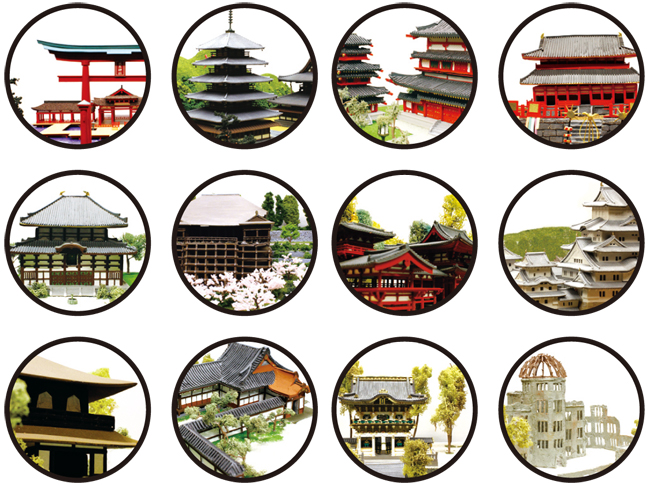
当たり前に日本人として生きてきた。でも海外に出てから、日本について何も知らないことに気が付いた。そこで、日本が世界に誇る世界遺産について建立年順に勉強しようと思う。興味がある人も、そうでない人も、しばしお付き合いを。
I’ve lived my whole life as a Japanese person, but when I went overseas I realised I know practically nothing about Japan. So now I’m learning about Japan’s World Heritage Sites, from oldest to newest. Those who are interested, and even those who are not, come along for the ride.

撮影協力 / メルボルン総領事館 Thanks to the Consulate-General of Japan, Melbourne
○○○○○ まずは世界遺産についてちょっとだけ ○○○○○
皆さんは『世界遺産』についてどれくらい知っていますか? 『すべての人類共通の遺産』ということは分かるけど、人工的建築物もあれば、原生林のような自然なものまであるし…、いまひとつ分からないという人が多いのではないでしょうか。日本にある世界遺産の紹介の前に、まずは世界遺産についてお話したいと思います。
世界遺産の誕生は、1960年代、ダムの建設によって水没の危機にさらされたエジプトのヌビア遺跡を救うため、ユネスコ(The United Nations Educational, Scientific and Cultural Organization)が遺跡の救済キャンペーンを行いました。これを機に、『人類共通の遺産』という世界遺産条約の基本的思想が広がり、1972年の『世界遺産条約』採択へと繋がっていきました。世界遺産は、この世界遺産条約に基づいて登録された文化財や自然環境のことを指します。
世界遺産には、文化遺産・自然遺産・複合遺産の3種類があり、有形の不動産が対象になっています。ユネスコによると、「文化遺産とは、顕著な普遍的価値を有する記念物、建造物群、遺跡、文化的景観など。自然遺産とは、顕著な普遍的価値を有する地形や地質、生態系、絶滅のおそれのある動植物の生息・生育地など。複合遺産とは、文化遺産と自然遺産の両方の価値を兼ね備えているもの」と、なっています。日本の文化遺産は厳島(いつくしま)神社や富士山、今年6月に登録された富岡製糸場など、自然遺産は、屋久(やく)島や白神(しらかみ)山地などが登録されています。日本には、複合遺産は存在しません。オーストラリアの文化遺産は、ロイヤル・エキシビジョン・ビルディングとカールトン庭園(VIC)やオペラハウス(NSW)など、自然遺産はグレート・バリア・リーフ(QLD)やパーヌルル国立公園(WA)など、複合遺産は、タスマニア原生地域(TAS)やウルル=カタ・ジュタ国立公園(NT)などが登録されています。
ところで、「2013年に登録された富士山は、なぜ自然遺産でなく文化遺産なの?」と、思った方もいるのではないでしょうか。ハイ、私も思いました。いろいろ調べてみたところによると、現在の富士山は、人々に利用されてきたことによって、本来の自然が残っているとはいえない状況にあり、「自然環境と人間の営みの中で、信仰や芸術・伝統的風習などが長い年月をかけて地域共同体と結びついた結果、形成された風景」という文化的景観の定義から文化遺産になったそうです。それなら複合遺産でも良いんじゃないかと思うのは、私だけでしょうか…。
ちなみに、富士山の世界遺産登録と同時期に話題になった『和食』は、『無形文化遺産』に登録されています。これは、世界遺産とは似て異なるもの。こちらもユネスコ事業のひとつで、世界遺産が建築物などの有形文化財を対象としているのに対し、地域ごとに多様な形態で存在する民族文化財や口承伝統など、無形文化財の保護と継承を目的にしています。
次回からは、世界遺産に登録されている建造物を紹介していきます。お楽しみに。
○○○○○ A little bit about World Heritage ○○○○○
How much do you know about World Heritage? You might know it means ‘common heritage for all humanity’, but some sites are structures made by humans whereas others are natural features... a lot of people are not exactly sure how it works. So before introducing Japan’s World Heritage Sites, I would like to talk a little bit about World Heritage itself.
The birth of World Heritage was in the 1960s, when UNESCO campaigned to save some Nubian ruins in Egypt that were going to be submerged by the construction of a dam. This campaign spread the basic idea of a treaty to preserve ‘common heritage for all humanity’, and in 1972 the ‘Convention concerning the Protection of the World Cultural and Natural Heritage’ was adopted. World Heritage Sites are places of natural or cultural importance that are registered on the UNESCO World Heritage list, in accordance with that convention.
There are three kinds of World Heritage Sites: cultural, natural, and mixed properties, all material places in the real world. According to UNESCO, cultural heritage refers to monuments, structures, ruins, and sites of outstanding universal value. Natural heritage refers to geographical and geological features, ecosystems, and endangered plants and animals of outstanding universal value. Mixed heritage is a property that is of both cultural and natural importance. Japan’s cultural World Heritage Sites include the Itsukushima Shinto Shrine, and Mount Fuji (which made the list last year). Some of Japan’s natural World Heritage Sites are Yakushima and Shirakami-Sanchi. Japan has no World Heritage listed mixed properties. Australia’s cultural sites on the World Heritage list include the Royal Exhibition Building and Carlton Gardens (Victoria), and the Sydney Opera House (New South Wales). Some of Australia’s natural World Heritage Sites are the Great Barrier Reef (Queensland) and Purnululu National Park (Western Australia). Mixed properties registered to the list include the Tasmanian Wilderness (Tasmania) and Uluru-Kata Tjuta National Park (Northern Territory).
By the way, some of you may be wondering why Mount Fuji is listed as a cultural site and not as a natural one. (I wondered too.) According to my research, the Mount Fuji of today has been changed from its original state by human use, and is defined as a cultural site because it is ‘a natural environment inhabited by humans, and shaped by its connection to the community over many years through spiritual beliefs, art, and traditional customs’. Is it just me wondering why they didn’t just class it as a mixed property?
Incidentally, around the same time the Mount Fuji joined the World Heritage List, also in the news was that ‘washoku’ (traditional Japanese cuisine) was added to the Intangible Cultural Heritage List. This list is also a UNESCO project, but aims to protect and preserve not tangible things like buildings but intangible treasures, such as the different folk cultures and oral traditions of different areas.
From next time, I look forward to introducing some World Heritage listed structures in Japan.

